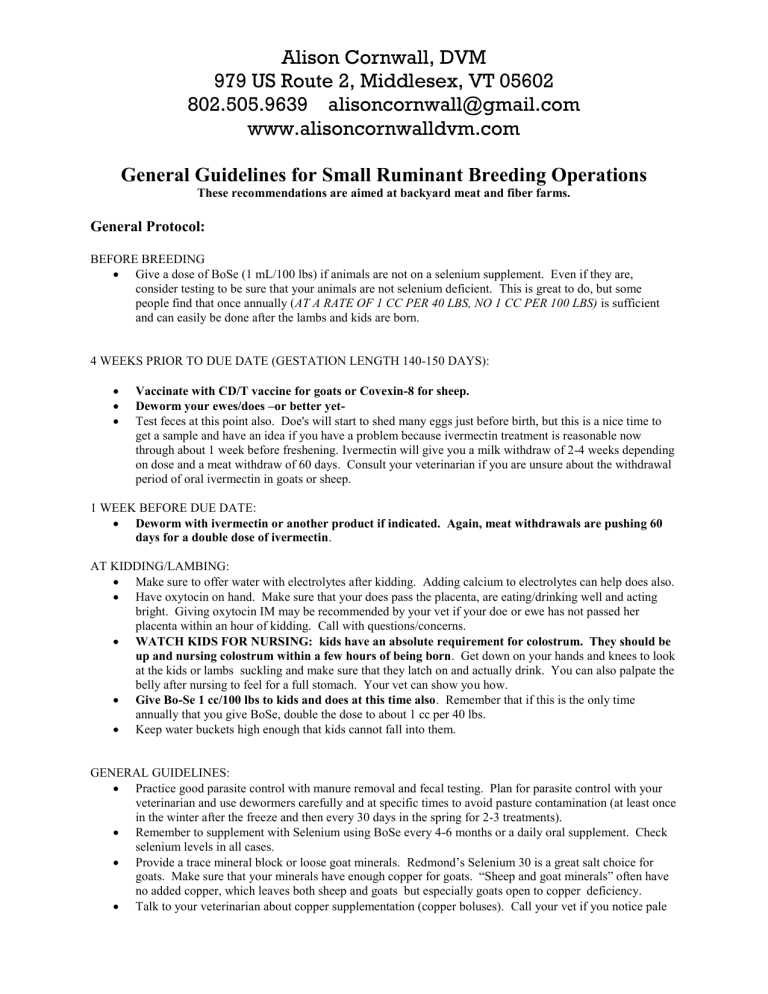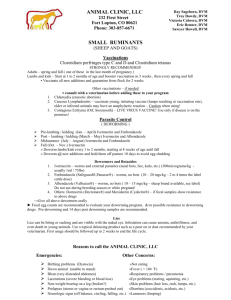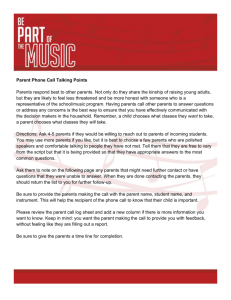Alison Cornwall, DVM 979 US Route 2, Middlesex, VT 05602

Alison Cornwall, DVM
979 US Route 2, Middlesex, VT 05602
802.505.9639 alisoncornwall@gmail.com www.alisoncornwalldvm.com
General Guidelines for Small Ruminant Breeding Operations
These recommendations are aimed at backyard meat and fiber farms.
General Protocol:
BEFORE BREEDING
Give a dose of BoSe (1 mL/100 lbs) if animals are not on a selenium supplement. Even if they are, consider testing to be sure that your animals are not selenium deficient. This is great to do, but some people find that once annually ( AT A RATE OF 1 CC PER 40 LBS, NO 1 CC PER 100 LBS) is sufficient and can easily be done after the lambs and kids are born.
4 WEEKS PRIOR TO DUE DATE (GESTATION LENGTH 140-150 DAYS):
Vaccinate with CD/T vaccine for goats or Covexin-8 for sheep.
Deworm your ewes/does –or better yet-
Test feces at this point also. Doe's will start to shed many eggs just before birth, but this is a nice time to get a sample and have an idea if you have a problem because ivermectin treatment is reasonable now through about 1 week before freshening. Ivermectin will give you a milk withdraw of 2-4 weeks depending on dose and a meat withdraw of 60 days. Consult your veterinarian if you are unsure about the withdrawal period of oral ivermectin in goats or sheep.
1 WEEK BEFORE DUE DATE:
Deworm with ivermectin or another product if indicated. Again, meat withdrawals are pushing 60 days for a double dose of ivermectin .
AT KIDDING/LAMBING:
Make sure to offer water with electrolytes after kidding. Adding calcium to electrolytes can help does also.
Have oxytocin on hand. Make sure that your does pass the placenta, are eating/drinking well and acting bright. Giving oxytocin IM may be recommended by your vet if your doe or ewe has not passed her placenta within an hour of kidding. Call with questions/concerns.
WATCH KIDS FOR NURSING: kids have an absolute requirement for colostrum. They should be up and nursing colostrum within a few hours of being born . Get down on your hands and knees to look at the kids or lambs suckling and make sure that they latch on and actually drink. You can also palpate the belly after nursing to feel for a full stomach. Your vet can show you how.
Give Bo-Se 1 cc/100 lbs to kids and does at this time also . Remember that if this is the only time annually that you give BoSe, double the dose to about 1 cc per 40 lbs.
Keep water buckets high enough that kids cannot fall into them.
GENERAL GUIDELINES:
Practice good parasite control with manure removal and fecal testing. Plan for parasite control with your veterinarian and use dewormers carefully and at specific times to avoid pasture contamination (at least once in the winter after the freeze and then every 30 days in the spring for 2-3 treatments).
Remember to supplement with Selenium using BoSe every 4-6 months or a daily oral supplement. Check selenium levels in all cases.
Provide a trace mineral block or loose goat minerals. Redmond’s Selenium 30 is a great salt choice for goats. Make sure that your minerals have enough copper for goats. “Sheep and goat minerals” often have no added copper, which leaves both sheep and goats but especially goats open to copper deficiency.
Talk to your veterinarian about copper supplementation (copper boluses). Call your vet if you notice pale
Alison Cornwall, DVM
979 US Route 2, Middlesex, VT 05602
802.505.9639 alisoncornwall@gmail.com www.alisoncornwalldvm.com haircoats or spots on the haircoats.
Vaccinate with CD/T for goats or Covexin-8 for sheep annually and before kidding.
Vaccinate with rabies vaccine annually.
Remember that goats need to eat 1-2% of their body weight in dry matter (dry hay and, for milking animals, dry grains) with a total protein content of 10-12%, with higher protein levels for milking animls
(aim for 15% protein). Milking animals can eat as much as 3% of BW per day, and should be offered as much high quality hay as they wish to eat.
General Kid/Lamb Protocol:
AT BIRTH:
1 mL BoSe IM. 1 mL is the minimum dose, so all young animals (even those weighing only a few pounds, should get 1 mL or 1 cc)
Betadine dip for umbilicus
Monitor that kids are nursing well and acting bright and alert. They should pass soft feces within several hours of birth.
BEGIN YOUR MONTHS-LONG MONITORING FOR DIARRHEA . Kids frequently get diarrhea, but they act totally normal, eat/nurse with alacrity, and have plenty of energy. Anytime that you see diarrhea that accompanies any decrease in a bright attitude or any decrease in appetite, call your vet immediately. Kids have almost no reserve and can decompensate and die quickly with diarrhea! Also call your vet if diarrhea persists beyond 2 days, even if the kids are acting fine.
AT ONE WEEK OF AGE:
Disbud if you plan on disbudding your goats.
This is also the time for “tagging.” Placing ear tags, castrating if you plan to band, etc. You may do BoSe at this time as well if you want to handle the animals only once. **More on castration below.
Begin offering hay and grain. They will probably reject most non-milk feeds for another week or two.
Band your buckling if you plan to do it yourself. Understand that by castrating early, you are setting male goats up for urinary stones. The best plan for male goats is to wait as long as possible before castrating so that the urethra has time to grow under the influence of testosterone, which will make it wider and less prone to urinary stone impaction.
AT ONE MONTH OF AGE
Vaccinate with CD/T vaccine for goats or Covexin-8 for sheep.
Likely deworm. At least test feces for parasites. Coccidia are a real problem in many small ruminant herds and this parasite will only begin to be shed by about 30 days of age.
Consider another BoSe shot if deficient.
TEST FECES. Most parasites will not shed eggs in the feces before this time. Testing feces for parasite eggs is particularly important at this time because it is crucial to understand if your kids need to be treated for coccidia parasites. If you know that you have a coccidia problem, you can just start a coccidiastat at this time. My clients, of course, are welcome to use my free service. The forms for testing are on my website under the client education tab, parasite section.
Alison Cornwall, DVM
979 US Route 2, Middlesex, VT 05602
802.505.9639 alisoncornwall@gmail.com www.alisoncornwalldvm.com
Begin Coccidia prevention if you have coccidia parasites. If you know that you have a problem, you may want to treat with a preventative earlier (2 weeks of age) next year.
AT 8 WEEKS OF AGE:
Second CD/T or Covexin vaccine.
If you have heavy worm burdens, deworm again.
AT 6 MONTHS OF AGE AND THEN ANNUALLY:
Rabies and CD/T or Covexin-8 vaccines.
Check feet and trim if necessary (every 6 months at least).
Remember to plan for parasite control. Test your animals feces and deworm selectively using a plan designed for your farm by your vet.
Your vet can surgically castrate at this time or as early as 2-4 months if indicated.
GENERAL GUIDELINES AND REMINDERS:
Watch for diarrhea always. Call your veterinarian immediately if a kid is depressed, not suckling, or has diarrhea.
Your kids and lambs (esp lambs!) should look glossy and fat and happy. Dull haircoats, thin babies, and babies without a lot of energy are a big warning sign.
Consider using a coccidiastat if you have had problems with coccidia. Usually this should be started about
14 days of age.
Test your kid’s feces for parasites early and frequently! Alternately, you can use FAMANCHA but know that FAMANCHA is looking only for blood loss from haemonchus and that by the time you have blood loss, you have significant parasite loads!!
Plan for deworming smartly by talking to your veterinarian.
You will probably want to deworm all kids around 45 days of age with fenbendazole.








